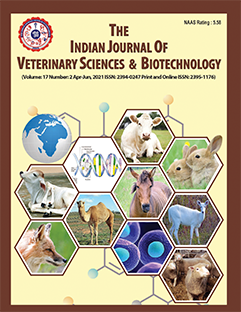Clinical and Radiological Evaluation of Silver Fluorophosphate in the Treatment of Long Bone Fractures in Dogs
DOI:
https://doi.org/10.48165/ijvsbt.21.6.13Keywords:
Dog, Locking compression plate, Long bone Fracture, Radiography, Silver fluorophosphate granules, Surgical managementAbstract
The objective of this study was to evaluate clinical and radiological effect of silver fluorophosphate for repair of long bone fractures in dogs. Twelve clinical cases of long bone fractures were divided into two groups having six animals in each group. In group I, long bone fractures were immobilized using a locking compression plate (LCP), while in group II long bone fractures were immobilized using LCP along with additional use of silver fluorophosphate granules. Post-surgery, modified Robert Jones bandaging provided limb support. Antibiotics and analgesics were administered and owners were instructed on wound care and limited movement of dogs for minimum 20 days. Radiographic examination and functional outcome of affected bone examination was carried out on the day of surgery and then on the 15th, 30th, 45th and 60th day post-operatively. Good clinical outcome in terms of post-operative fracture healing and lameness score was observed in group I compared to group II. The poor outcome in group II might be due to fracture complexity, sex-specific and breed-specific behaviour, and limited post-operative care. Post-operative complications observed mainly in group II included self mutilation of the wound, screw dislodgment, plate bending, and bone osteolysis.
Downloads
References
Al-Harby, S.W., Samy, M.T., El Naggar, M.I., Al-Damegh, S.A., & Nooreldin, M.A. (1996). Delayed healing of experimental fractures in the denervated limbs of dogs: Clinical and radiological study. Bahrain Medical Bulletin, 18(1), 16–19.
Ayyappan, S., Shafiuzama, M., Ganesh, T.N., Das, B.C., & Kumar, R.S. (2009). A clinical study on external fixators for long bone fracture management in dogs. Indian Journal of Veterinary Surgery, 30(2), 90–92.
Bhadesiya, C.M., & Raval, S.K. (2014). Percentage analysis of knowledge level for dog-ownership in rural areas of Gujarat. International Journal of Social Science and Human Research, 2(4), 300–302.
Cabassu, J.P. (2001). Elastic plate osteosynthesis of femoral shaft fractures in young dogs. Veterinary and Comparative Orthopaedics and Traumatology, 14(1), 40–45.
Coutinho, N., Singh, V., & Lokhande, D.U. (2015). Management of unstable diaphyseal fractures of long bones with dynamic compression plate fixation in six dogs. Indian Journal of Veterinary Surgery, 36(1), 63.
Fossum, T.W. (2007). Tibia and fibular fracture – management of specific fracture. In Textbook of Small Animal Surgery (3rd edn., pp. 1126–1135). Mosby Elsevier.
Hammer, R.R., Hammerby, S., & Lindholm, B. (1985). Accuracy of radiologic assessment of tibial shaft fracture union in humans. Clinical Orthopaedics and Related Research, 199, 233–238.
Marvaniya, N.T. (2019). Comparative clinical studies on minimally invasive plate osteosynthesis and open plating techniques for repair of long bone fractures in dogs. M.V.Sc. Thesis, Junagadh Agricultural University, Junagadh, Gujarat, India.
Nojiri, A., Nishido, T., Horinaka, O., Akiyoshi, H., Ohashi, F., & Yamaguchi, T. (2015). Initial clinical application and results of the advanced locking plate system (ALPS) in small animal orthopedics: 282 procedures. International Journal of Applied Research in Veterinary Medicine, 13(1), 64–79.
Schwandt, C.S., & Montavon, P.M. (2005). Locking compression plate fixation of radial and tibial fractures in a young dog. Veterinary and Comparative Orthopaedics and Traumatology, 18(3), 194–198.
Sean Hoover, Tarafder, S., Bandyopadhyay, A., & Bose, S. (2017). Silver doped resorbable tricalcium phosphate scaffolds for bone graft applications. Materials Science and Engineering C, 79, 763–769.
Singh, K. (2019). Comparative evaluation of locking compression plate and cuttable plates for long bone fracture repair in dogs. M.V.Sc. Thesis, Nagpur Veterinary College, MAFSU, Nagpur, Maharashtra, India.
Tyagi, R.P.S., & Singh, J. (2008). Fractures. The musculoskeletal system, Section D, pp. 343. In Textbook of Ruminant Surgery. CBS Publishers and Distributors, New Delhi, India.
Vasseur, P.B., Johnson, A.L., Budsberg, S.C., Lincoln, J.D., Toombs, J.P., Whitehair, J.G., & Lentz, E.L. (1995). Randomized, controlled trial of the efficacy of carprofen, a nonsteroidal anti-inflammatory drug, in the treatment of osteoarthritis in dogs. Journal of the American Veterinary Medical Association, 206(6), 807–811.
Wagner, M. (2003). General principles for the clinical use of the LCP. Injury, 34(2), 31–42.
Xue, Z., Xu, H., Ding, H., Qin, H., & An, Z. (2016). Comparison of the effect on bone healing process of different implants used in minimally invasive plate osteosynthesis: Limited contact dynamic compression plate versus locking compression plate. Scientific Reports, 6, 37902.
Yadav, G.U., Sarkate, L.B., Lokhande, D.U., & Khandekar, G.S. (2016). Long bone fractures and its repair in dogs – A study of 10 patients. Intas Polivet, 17(1), 6–8.
Yuvaraj, H., Dilipkumar, D., Shivaprakash, B.V., & Usturge, S.M. (2007). Comparative evaluation of DCP with PMMA plate for femur and radius fracture in dogs. Indian Journal of Veterinary Surgery, 28(1), 1–5.*
Downloads
Published
Issue
Section
License
Copyright (c) 2025 Indian Journal of Veterinary Sciences and Biotechnology

This work is licensed under a Creative Commons Attribution-NonCommercial-NoDerivatives 4.0 International License.




